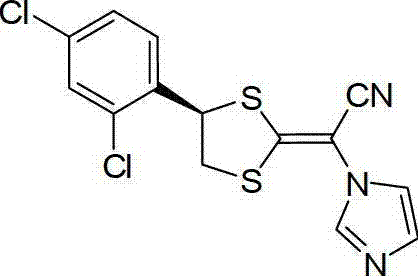Method for synthesizing luliconazole intermediate-(S)-2,4-dichloro-1-(1,2-dichloroethyl) benzene
A technology of luliconazole and dichloroethyl, which is applied in the field of chemical synthesis technology, can solve the problems of difficult industrialization, high cost, and low yield, and achieve the effect of less organic solvent consumption, high yield, and low dosage
- Summary
- Abstract
- Description
- Claims
- Application Information
AI Technical Summary
Problems solved by technology
Method used
Image
Examples
preparation example Construction
[0044] The synthetic method of luliconazole intermediate (S)-2,4-dichloro-1-(1,2-dichloroethyl)benzene comprises the following steps:
[0045] a. Under the protection of nitrogen, heat (S,S)-TsDPEN and the transition metal complex precursor in degassed water to 35-40°C and react for 1-2 hours to make a chiral catalyst; the transition metal The complex precursor is [Ru(p-cymene)Cl 2 ] 2 、[Cp*RhCl 2 ] 2 or [Cp*Ir Cl 2 ] 2 one of
[0046] b. Add ω-chloro-2,4-dichloroacetophenone, surfactant or phase transfer catalyst, and hydrogen source to the chiral catalyst degassed water system described in step a for reaction; the reaction temperature is 10 ~70℃, the reaction time is 6~20 hours;
[0047] c. After the reaction is complete, extract with n-hexane. After the extract is dried, remove the solid by filtration, concentrate the filtrate to dryness, recrystallize with n-hexane, and dry the solid to obtain (R)-2-chloro-1-(2,4- Dichlorophenyl) ethanol;
[0048] d. Under the pro...
Embodiment 1
[0063] a, under nitrogen protection, 0.31 grams of ruthenium complex precursor [Ru(p-cymene)Cl 2 ] 2 Add 0.67 g of optically pure (S,S)-TsDPEN into a 250 ml reaction flask, then add 100 ml of degassed water, heat to 40°C, and react for 1 hour.
[0064] b. Add 0.25 grams of CTAB (cetyltrimethylammonium bromide) and 52 grams of HCO to the above reaction solution 2 Na·2H 2 O (sodium formate) and 22 g of ω-chloro-2,4-dichloroacetophenone, the reaction temperature is 28 ° C, and the reaction temperature is maintained for 14 hours.
[0065] c. After the reaction is complete, add n-hexane to extract the product, dry the extract with anhydrous sodium sulfate, filter off the sodium sulfate, concentrate the filtrate to dryness, add 55 ml of n-hexane to heat and dissolve, then drop to room temperature for crystallization, and filter. After drying, 21.2 g of (R)-2-chloro-1-(2,4-dichlorophenyl)ethanol was obtained, with an optical purity of 99.2%.
[0066] d. Synthesis of (S)-2,4-dichl...
Embodiment 2
[0069] The recycling of embodiment 2 catalyst
[0070] After step c of Example 1 extracted the product with n-hexane, the water phase was transferred to a 250 ml reaction flask, and under nitrogen protection, 22 grams of ω-chloro-2,4-dichloroacetophenone was added, 4.1 ml of formic acid was added to adjust the pH value of the reaction solution to 7.2, and the reaction was carried out at 28° C. for 14 hours. After the reaction is complete, other operations are the same as steps c and d of Example 1.
[0071] 21.0 g of the product (S)-2,4-dichloro-1-(1,2-dichloroethyl)benzene was obtained, with a yield of 95.0% and an optical purity of 99.2%.
[0072] The detection conditions of the optical purity of the final product are the same as in Example 1.
PUM
| Property | Measurement | Unit |
|---|---|---|
| wavelength | aaaaa | aaaaa |
| optical purity | aaaaa | aaaaa |
| optical purity | aaaaa | aaaaa |
Abstract
Description
Claims
Application Information
 Login to View More
Login to View More - R&D
- Intellectual Property
- Life Sciences
- Materials
- Tech Scout
- Unparalleled Data Quality
- Higher Quality Content
- 60% Fewer Hallucinations
Browse by: Latest US Patents, China's latest patents, Technical Efficacy Thesaurus, Application Domain, Technology Topic, Popular Technical Reports.
© 2025 PatSnap. All rights reserved.Legal|Privacy policy|Modern Slavery Act Transparency Statement|Sitemap|About US| Contact US: help@patsnap.com



